Research Methodology Report: PPP Risk Allocation in Australia
VerifiedAdded on 2020/04/15
|23
|4255
|115
Report
AI Summary
This research report investigates the allocation of risks in Public-Private Partnership (PPP) projects within the Australian construction industry. The report begins with an introduction, outlining the research background, rationale, aim, objectives, and research questions, including a hypothesis about the impact of risk allocation on operational efficiency and innovation. The second section details the research plan, including a comprehensive literature review on PPPs and risk allocation, discussing various systems of inquiry (induction, deduction, and abduction) and empirical approaches. The research employs a deductive system, focusing on express knowledge from literature to analyze risk allocation impacts. The research design is also discussed. The report aims to determine effective strategies for risk allocation between public and private parties in PPP projects, collecting data through surveys and analyzing it to develop a suitable framework. The findings and analysis are expected to contribute to better project management and innovation in the construction sector.
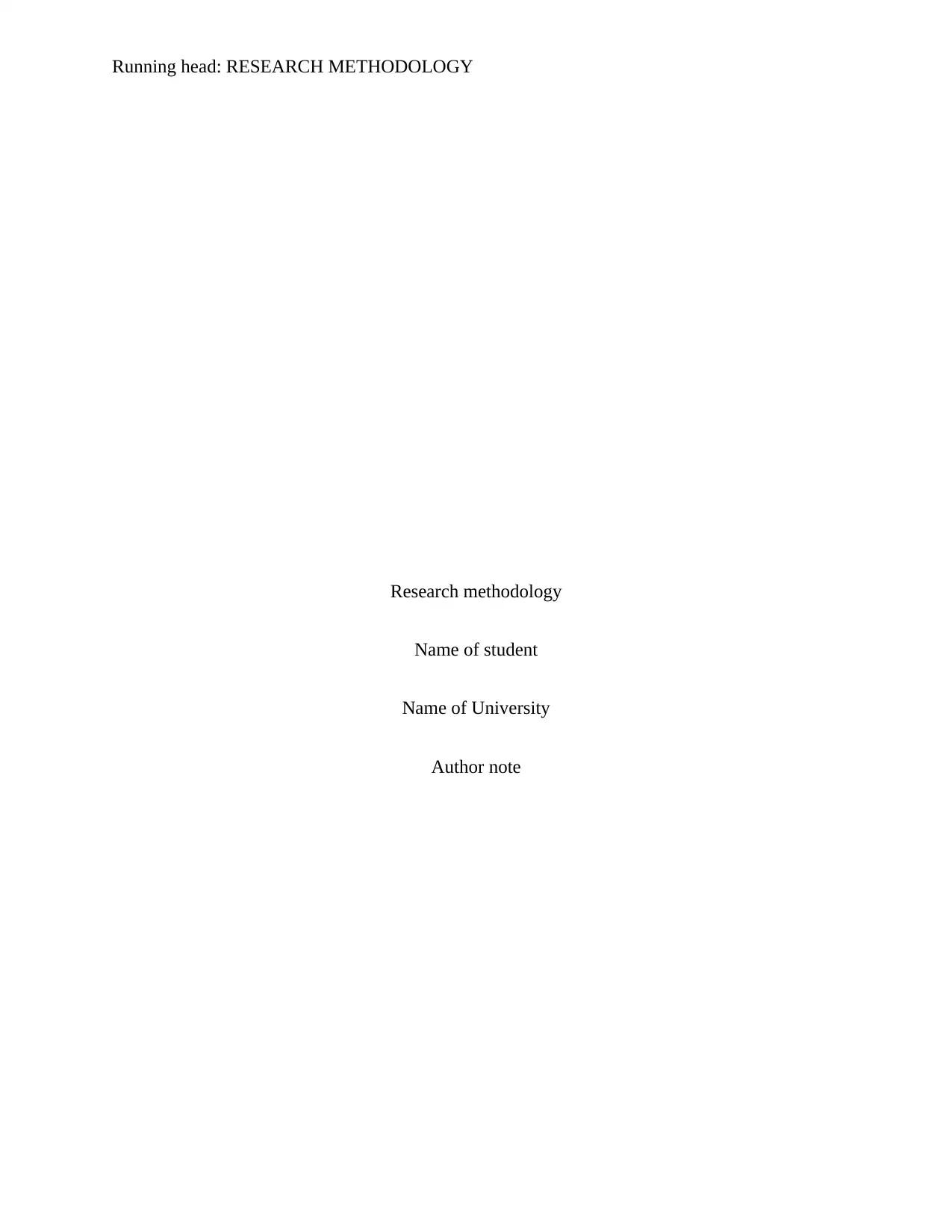
Running head: RESEARCH METHODOLOGY
Research methodology
Name of student
Name of University
Author note
Research methodology
Name of student
Name of University
Author note
Paraphrase This Document
Need a fresh take? Get an instant paraphrase of this document with our AI Paraphraser
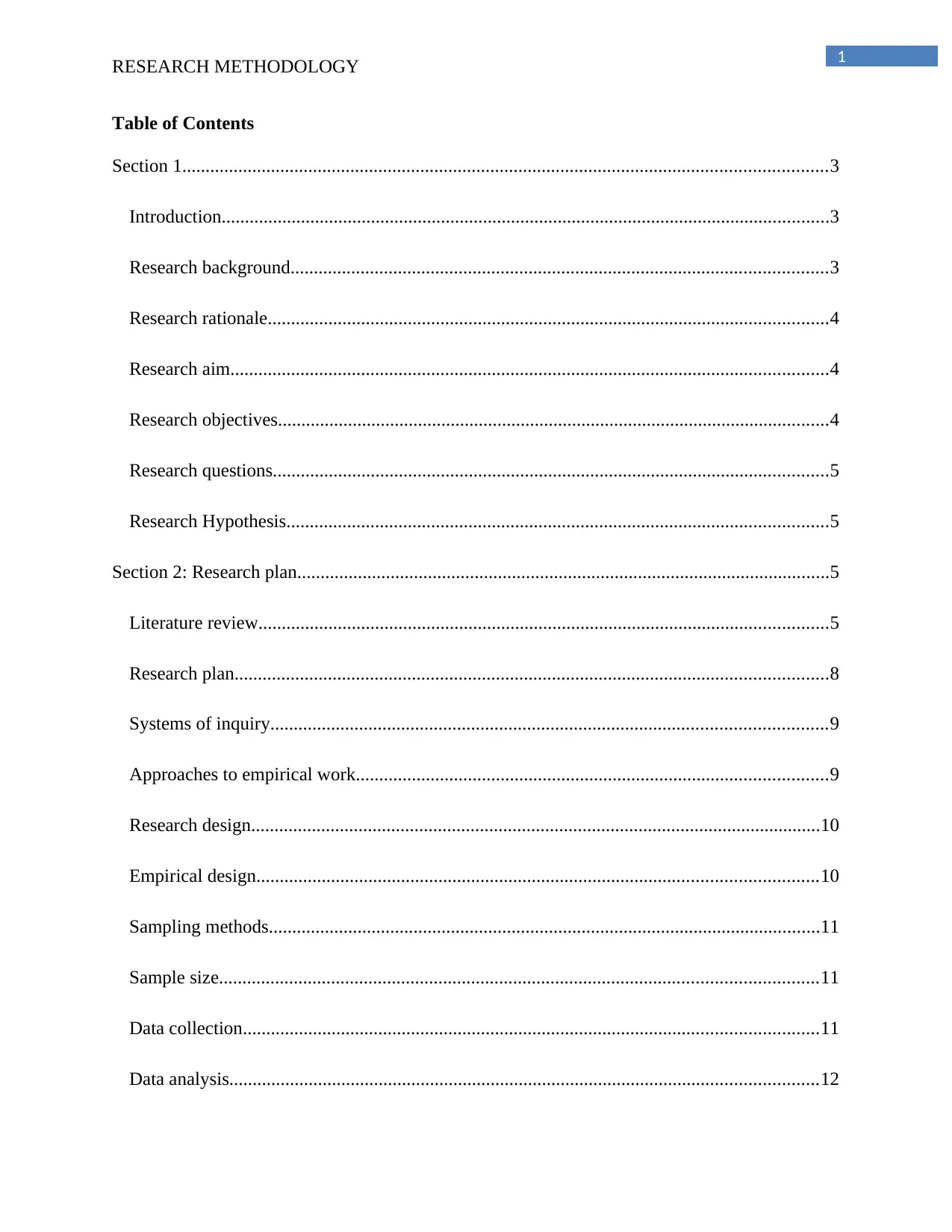
1
RESEARCH METHODOLOGY
Table of Contents
Section 1..........................................................................................................................................3
Introduction..................................................................................................................................3
Research background...................................................................................................................3
Research rationale........................................................................................................................4
Research aim................................................................................................................................4
Research objectives......................................................................................................................4
Research questions.......................................................................................................................5
Research Hypothesis....................................................................................................................5
Section 2: Research plan..................................................................................................................5
Literature review..........................................................................................................................5
Research plan...............................................................................................................................8
Systems of inquiry.......................................................................................................................9
Approaches to empirical work.....................................................................................................9
Research design..........................................................................................................................10
Empirical design........................................................................................................................10
Sampling methods......................................................................................................................11
Sample size................................................................................................................................11
Data collection...........................................................................................................................11
Data analysis..............................................................................................................................12
RESEARCH METHODOLOGY
Table of Contents
Section 1..........................................................................................................................................3
Introduction..................................................................................................................................3
Research background...................................................................................................................3
Research rationale........................................................................................................................4
Research aim................................................................................................................................4
Research objectives......................................................................................................................4
Research questions.......................................................................................................................5
Research Hypothesis....................................................................................................................5
Section 2: Research plan..................................................................................................................5
Literature review..........................................................................................................................5
Research plan...............................................................................................................................8
Systems of inquiry.......................................................................................................................9
Approaches to empirical work.....................................................................................................9
Research design..........................................................................................................................10
Empirical design........................................................................................................................10
Sampling methods......................................................................................................................11
Sample size................................................................................................................................11
Data collection...........................................................................................................................11
Data analysis..............................................................................................................................12

2
RESEARCH METHODOLOGY
Values and ethics.......................................................................................................................12
Section 3........................................................................................................................................12
References......................................................................................................................................15
RESEARCH METHODOLOGY
Values and ethics.......................................................................................................................12
Section 3........................................................................................................................................12
References......................................................................................................................................15
⊘ This is a preview!⊘
Do you want full access?
Subscribe today to unlock all pages.

Trusted by 1+ million students worldwide
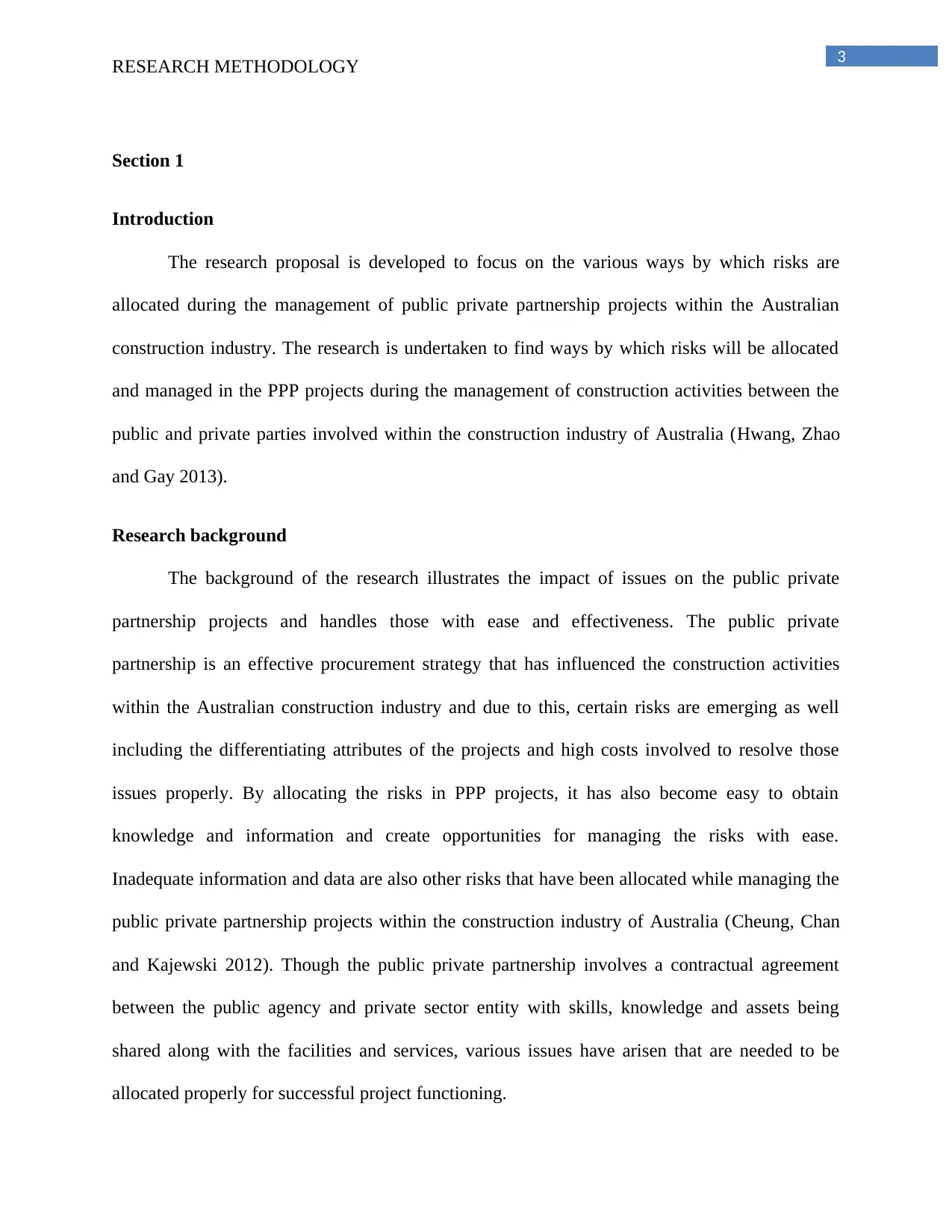
3
RESEARCH METHODOLOGY
Section 1
Introduction
The research proposal is developed to focus on the various ways by which risks are
allocated during the management of public private partnership projects within the Australian
construction industry. The research is undertaken to find ways by which risks will be allocated
and managed in the PPP projects during the management of construction activities between the
public and private parties involved within the construction industry of Australia (Hwang, Zhao
and Gay 2013).
Research background
The background of the research illustrates the impact of issues on the public private
partnership projects and handles those with ease and effectiveness. The public private
partnership is an effective procurement strategy that has influenced the construction activities
within the Australian construction industry and due to this, certain risks are emerging as well
including the differentiating attributes of the projects and high costs involved to resolve those
issues properly. By allocating the risks in PPP projects, it has also become easy to obtain
knowledge and information and create opportunities for managing the risks with ease.
Inadequate information and data are also other risks that have been allocated while managing the
public private partnership projects within the construction industry of Australia (Cheung, Chan
and Kajewski 2012). Though the public private partnership involves a contractual agreement
between the public agency and private sector entity with skills, knowledge and assets being
shared along with the facilities and services, various issues have arisen that are needed to be
allocated properly for successful project functioning.
RESEARCH METHODOLOGY
Section 1
Introduction
The research proposal is developed to focus on the various ways by which risks are
allocated during the management of public private partnership projects within the Australian
construction industry. The research is undertaken to find ways by which risks will be allocated
and managed in the PPP projects during the management of construction activities between the
public and private parties involved within the construction industry of Australia (Hwang, Zhao
and Gay 2013).
Research background
The background of the research illustrates the impact of issues on the public private
partnership projects and handles those with ease and effectiveness. The public private
partnership is an effective procurement strategy that has influenced the construction activities
within the Australian construction industry and due to this, certain risks are emerging as well
including the differentiating attributes of the projects and high costs involved to resolve those
issues properly. By allocating the risks in PPP projects, it has also become easy to obtain
knowledge and information and create opportunities for managing the risks with ease.
Inadequate information and data are also other risks that have been allocated while managing the
public private partnership projects within the construction industry of Australia (Cheung, Chan
and Kajewski 2012). Though the public private partnership involves a contractual agreement
between the public agency and private sector entity with skills, knowledge and assets being
shared along with the facilities and services, various issues have arisen that are needed to be
allocated properly for successful project functioning.
Paraphrase This Document
Need a fresh take? Get an instant paraphrase of this document with our AI Paraphraser
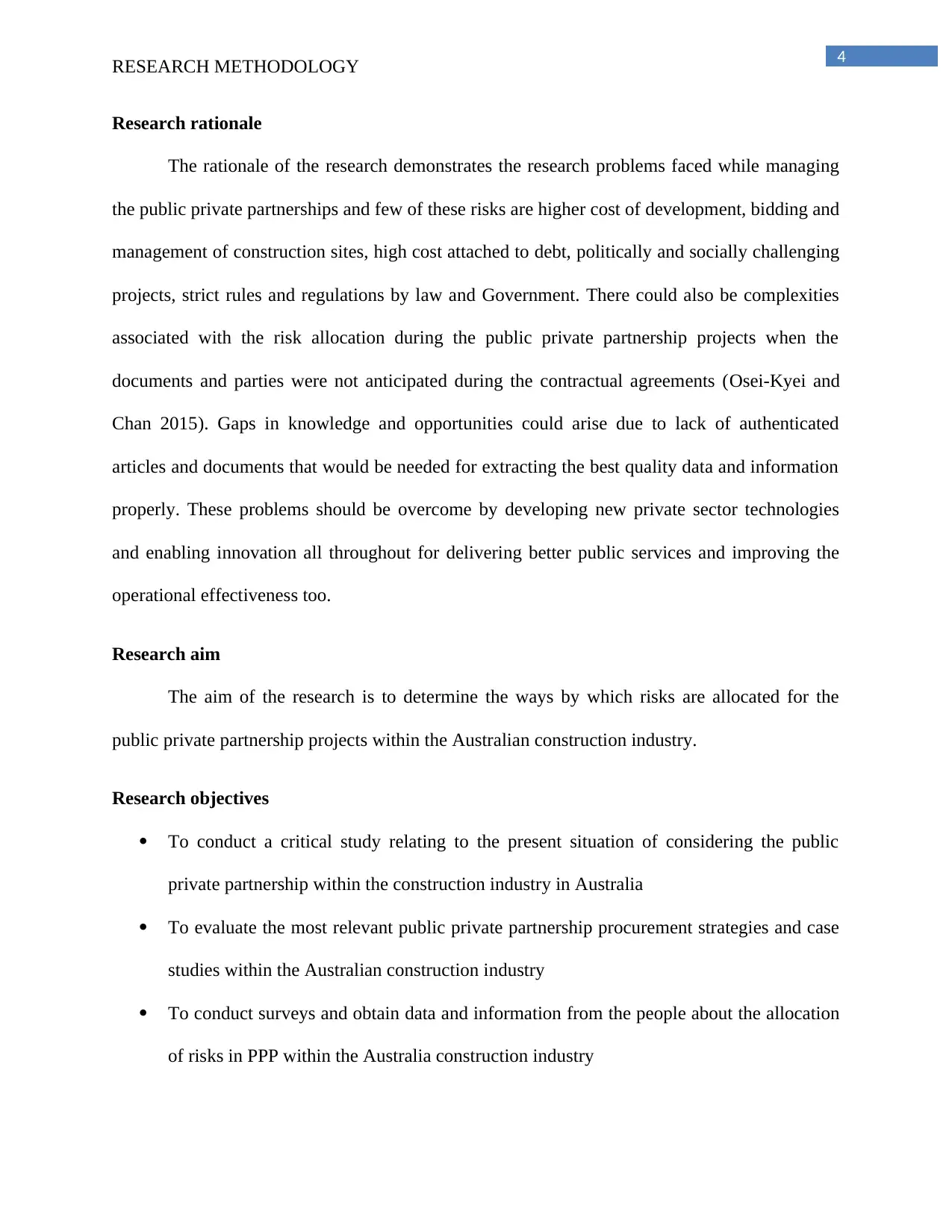
4
RESEARCH METHODOLOGY
Research rationale
The rationale of the research demonstrates the research problems faced while managing
the public private partnerships and few of these risks are higher cost of development, bidding and
management of construction sites, high cost attached to debt, politically and socially challenging
projects, strict rules and regulations by law and Government. There could also be complexities
associated with the risk allocation during the public private partnership projects when the
documents and parties were not anticipated during the contractual agreements (Osei-Kyei and
Chan 2015). Gaps in knowledge and opportunities could arise due to lack of authenticated
articles and documents that would be needed for extracting the best quality data and information
properly. These problems should be overcome by developing new private sector technologies
and enabling innovation all throughout for delivering better public services and improving the
operational effectiveness too.
Research aim
The aim of the research is to determine the ways by which risks are allocated for the
public private partnership projects within the Australian construction industry.
Research objectives
To conduct a critical study relating to the present situation of considering the public
private partnership within the construction industry in Australia
To evaluate the most relevant public private partnership procurement strategies and case
studies within the Australian construction industry
To conduct surveys and obtain data and information from the people about the allocation
of risks in PPP within the Australia construction industry
RESEARCH METHODOLOGY
Research rationale
The rationale of the research demonstrates the research problems faced while managing
the public private partnerships and few of these risks are higher cost of development, bidding and
management of construction sites, high cost attached to debt, politically and socially challenging
projects, strict rules and regulations by law and Government. There could also be complexities
associated with the risk allocation during the public private partnership projects when the
documents and parties were not anticipated during the contractual agreements (Osei-Kyei and
Chan 2015). Gaps in knowledge and opportunities could arise due to lack of authenticated
articles and documents that would be needed for extracting the best quality data and information
properly. These problems should be overcome by developing new private sector technologies
and enabling innovation all throughout for delivering better public services and improving the
operational effectiveness too.
Research aim
The aim of the research is to determine the ways by which risks are allocated for the
public private partnership projects within the Australian construction industry.
Research objectives
To conduct a critical study relating to the present situation of considering the public
private partnership within the construction industry in Australia
To evaluate the most relevant public private partnership procurement strategies and case
studies within the Australian construction industry
To conduct surveys and obtain data and information from the people about the allocation
of risks in PPP within the Australia construction industry

5
RESEARCH METHODOLOGY
To collect relevant data and information and find out how risks are allocated between the
public and private parties to manage the PPP projects within the construction industry,
Australia
To conduct analysis of the information and data and develop a suitable framework for
allocating the risks in PPP between both public and private parties
Research questions
How can the critical study of the literature provide an overview of the entire situation related to
the allocation of risks for the PPPs in Australian construction industry?
What are the most effective public private partnership procurement strategies managed within
the construction industry of Australia?
How could the surveys, data and information collected could help in allocating the risks in PPP
for the construction industry?
How could be the analysis of data and information help in the management of a suitable
framework to allocate risks in PP for both the public and private parties?
Research Hypothesis
H0: The allocation of risks in public private partnership projects cannot create any positive
impact on the operational efficiency and promote innovation
H1: Risk allocation in PPPs within the construction industry of Australia could help in
implementing new technologies and deliver best quality pubic services along with betterment of
operational effectiveness.
RESEARCH METHODOLOGY
To collect relevant data and information and find out how risks are allocated between the
public and private parties to manage the PPP projects within the construction industry,
Australia
To conduct analysis of the information and data and develop a suitable framework for
allocating the risks in PPP between both public and private parties
Research questions
How can the critical study of the literature provide an overview of the entire situation related to
the allocation of risks for the PPPs in Australian construction industry?
What are the most effective public private partnership procurement strategies managed within
the construction industry of Australia?
How could the surveys, data and information collected could help in allocating the risks in PPP
for the construction industry?
How could be the analysis of data and information help in the management of a suitable
framework to allocate risks in PP for both the public and private parties?
Research Hypothesis
H0: The allocation of risks in public private partnership projects cannot create any positive
impact on the operational efficiency and promote innovation
H1: Risk allocation in PPPs within the construction industry of Australia could help in
implementing new technologies and deliver best quality pubic services along with betterment of
operational effectiveness.
⊘ This is a preview!⊘
Do you want full access?
Subscribe today to unlock all pages.

Trusted by 1+ million students worldwide
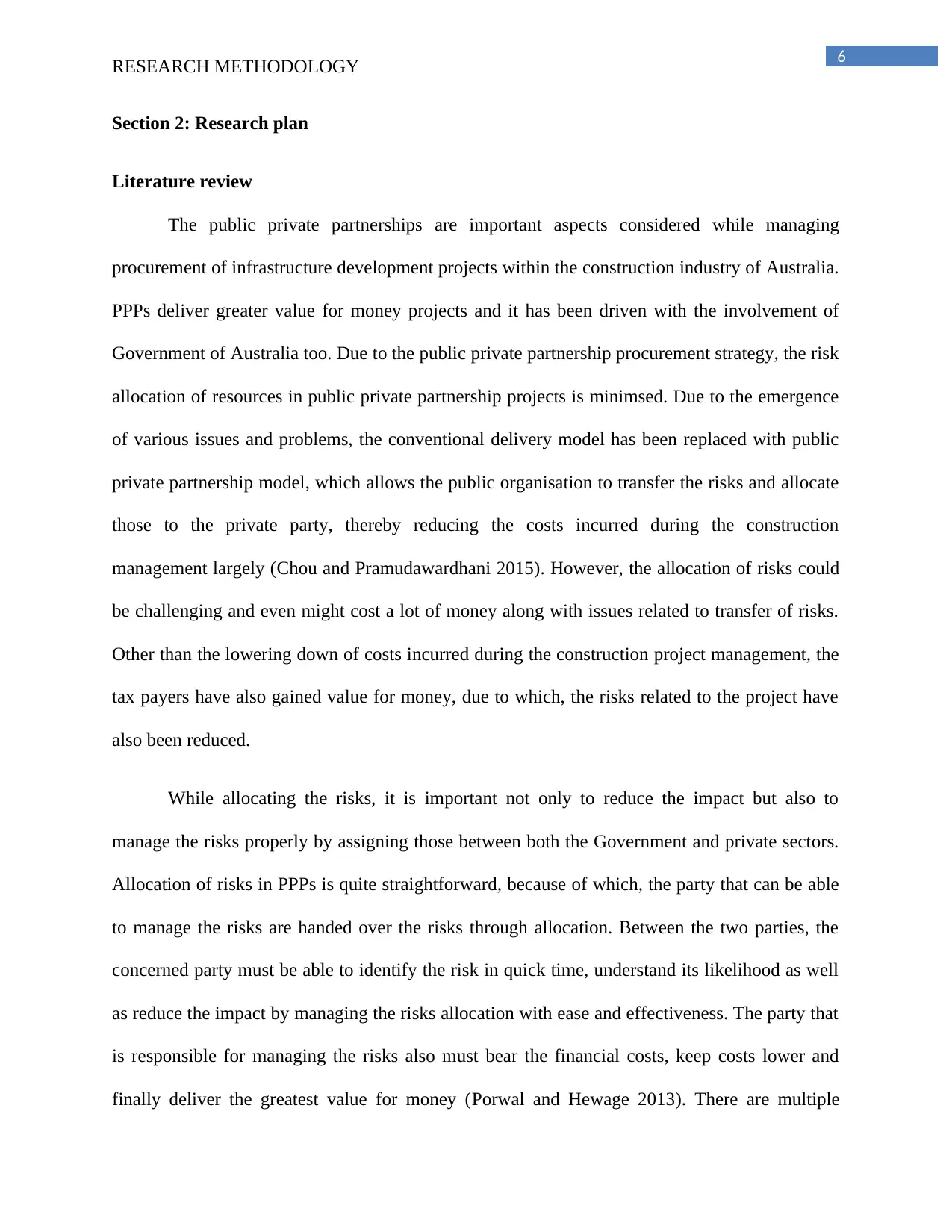
6
RESEARCH METHODOLOGY
Section 2: Research plan
Literature review
The public private partnerships are important aspects considered while managing
procurement of infrastructure development projects within the construction industry of Australia.
PPPs deliver greater value for money projects and it has been driven with the involvement of
Government of Australia too. Due to the public private partnership procurement strategy, the risk
allocation of resources in public private partnership projects is minimsed. Due to the emergence
of various issues and problems, the conventional delivery model has been replaced with public
private partnership model, which allows the public organisation to transfer the risks and allocate
those to the private party, thereby reducing the costs incurred during the construction
management largely (Chou and Pramudawardhani 2015). However, the allocation of risks could
be challenging and even might cost a lot of money along with issues related to transfer of risks.
Other than the lowering down of costs incurred during the construction project management, the
tax payers have also gained value for money, due to which, the risks related to the project have
also been reduced.
While allocating the risks, it is important not only to reduce the impact but also to
manage the risks properly by assigning those between both the Government and private sectors.
Allocation of risks in PPPs is quite straightforward, because of which, the party that can be able
to manage the risks are handed over the risks through allocation. Between the two parties, the
concerned party must be able to identify the risk in quick time, understand its likelihood as well
as reduce the impact by managing the risks allocation with ease and effectiveness. The party that
is responsible for managing the risks also must bear the financial costs, keep costs lower and
finally deliver the greatest value for money (Porwal and Hewage 2013). There are multiple
RESEARCH METHODOLOGY
Section 2: Research plan
Literature review
The public private partnerships are important aspects considered while managing
procurement of infrastructure development projects within the construction industry of Australia.
PPPs deliver greater value for money projects and it has been driven with the involvement of
Government of Australia too. Due to the public private partnership procurement strategy, the risk
allocation of resources in public private partnership projects is minimsed. Due to the emergence
of various issues and problems, the conventional delivery model has been replaced with public
private partnership model, which allows the public organisation to transfer the risks and allocate
those to the private party, thereby reducing the costs incurred during the construction
management largely (Chou and Pramudawardhani 2015). However, the allocation of risks could
be challenging and even might cost a lot of money along with issues related to transfer of risks.
Other than the lowering down of costs incurred during the construction project management, the
tax payers have also gained value for money, due to which, the risks related to the project have
also been reduced.
While allocating the risks, it is important not only to reduce the impact but also to
manage the risks properly by assigning those between both the Government and private sectors.
Allocation of risks in PPPs is quite straightforward, because of which, the party that can be able
to manage the risks are handed over the risks through allocation. Between the two parties, the
concerned party must be able to identify the risk in quick time, understand its likelihood as well
as reduce the impact by managing the risks allocation with ease and effectiveness. The party that
is responsible for managing the risks also must bear the financial costs, keep costs lower and
finally deliver the greatest value for money (Porwal and Hewage 2013). There are multiple
Paraphrase This Document
Need a fresh take? Get an instant paraphrase of this document with our AI Paraphraser
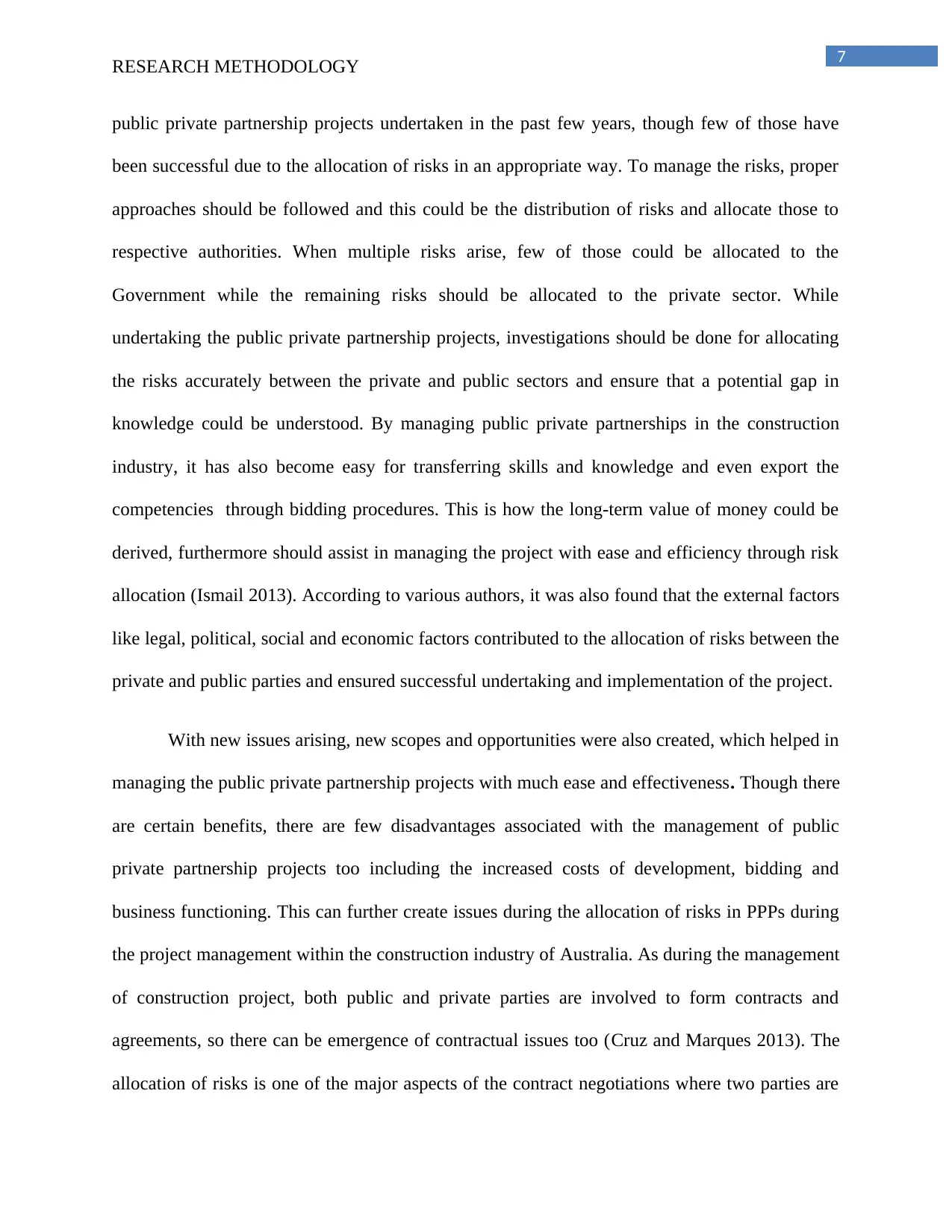
7
RESEARCH METHODOLOGY
public private partnership projects undertaken in the past few years, though few of those have
been successful due to the allocation of risks in an appropriate way. To manage the risks, proper
approaches should be followed and this could be the distribution of risks and allocate those to
respective authorities. When multiple risks arise, few of those could be allocated to the
Government while the remaining risks should be allocated to the private sector. While
undertaking the public private partnership projects, investigations should be done for allocating
the risks accurately between the private and public sectors and ensure that a potential gap in
knowledge could be understood. By managing public private partnerships in the construction
industry, it has also become easy for transferring skills and knowledge and even export the
competencies through bidding procedures. This is how the long-term value of money could be
derived, furthermore should assist in managing the project with ease and efficiency through risk
allocation (Ismail 2013). According to various authors, it was also found that the external factors
like legal, political, social and economic factors contributed to the allocation of risks between the
private and public parties and ensured successful undertaking and implementation of the project.
With new issues arising, new scopes and opportunities were also created, which helped in
managing the public private partnership projects with much ease and effectiveness. Though there
are certain benefits, there are few disadvantages associated with the management of public
private partnership projects too including the increased costs of development, bidding and
business functioning. This can further create issues during the allocation of risks in PPPs during
the project management within the construction industry of Australia. As during the management
of construction project, both public and private parties are involved to form contracts and
agreements, so there can be emergence of contractual issues too (Cruz and Marques 2013). The
allocation of risks is one of the major aspects of the contract negotiations where two parties are
RESEARCH METHODOLOGY
public private partnership projects undertaken in the past few years, though few of those have
been successful due to the allocation of risks in an appropriate way. To manage the risks, proper
approaches should be followed and this could be the distribution of risks and allocate those to
respective authorities. When multiple risks arise, few of those could be allocated to the
Government while the remaining risks should be allocated to the private sector. While
undertaking the public private partnership projects, investigations should be done for allocating
the risks accurately between the private and public sectors and ensure that a potential gap in
knowledge could be understood. By managing public private partnerships in the construction
industry, it has also become easy for transferring skills and knowledge and even export the
competencies through bidding procedures. This is how the long-term value of money could be
derived, furthermore should assist in managing the project with ease and efficiency through risk
allocation (Ismail 2013). According to various authors, it was also found that the external factors
like legal, political, social and economic factors contributed to the allocation of risks between the
private and public parties and ensured successful undertaking and implementation of the project.
With new issues arising, new scopes and opportunities were also created, which helped in
managing the public private partnership projects with much ease and effectiveness. Though there
are certain benefits, there are few disadvantages associated with the management of public
private partnership projects too including the increased costs of development, bidding and
business functioning. This can further create issues during the allocation of risks in PPPs during
the project management within the construction industry of Australia. As during the management
of construction project, both public and private parties are involved to form contracts and
agreements, so there can be emergence of contractual issues too (Cruz and Marques 2013). The
allocation of risks is one of the major aspects of the contract negotiations where two parties are
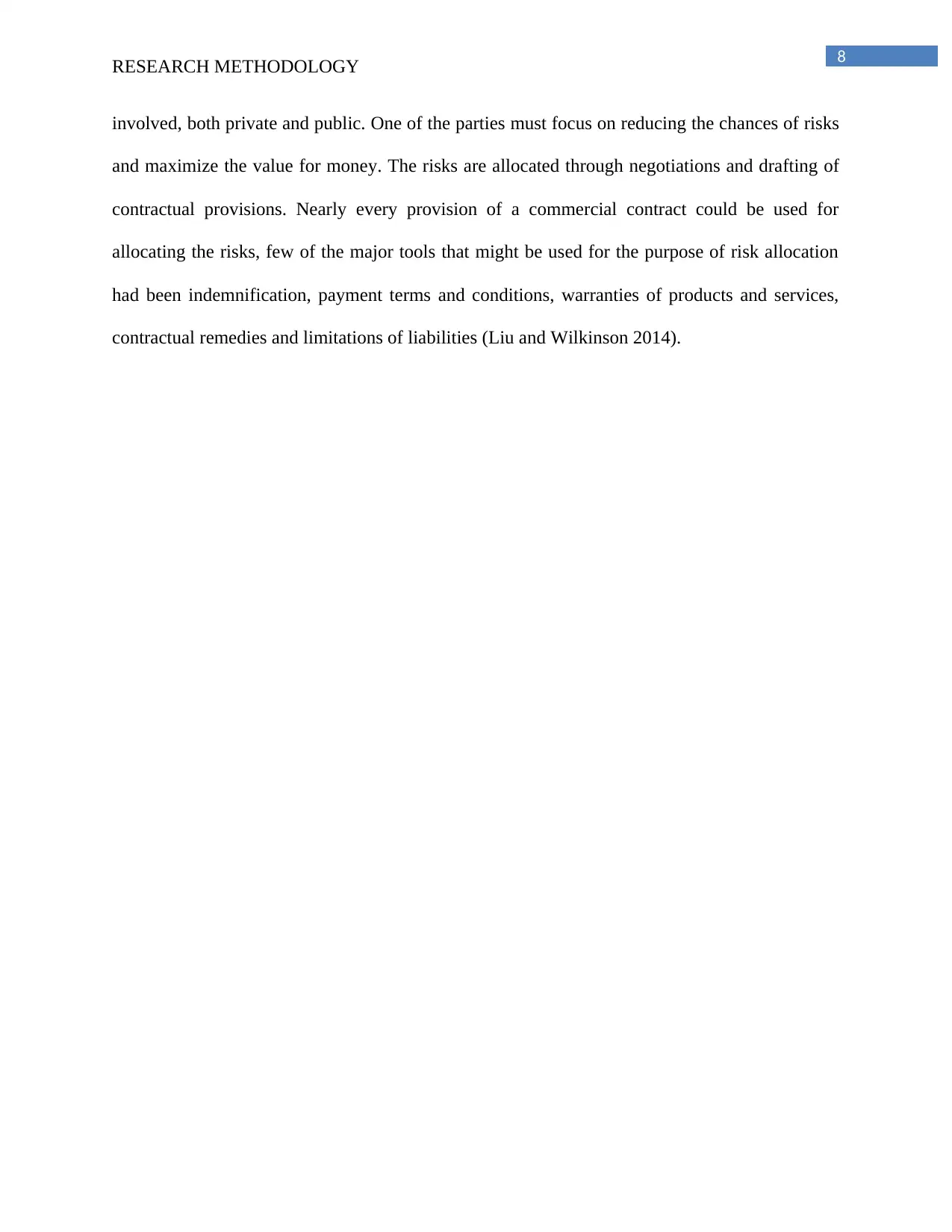
8
RESEARCH METHODOLOGY
involved, both private and public. One of the parties must focus on reducing the chances of risks
and maximize the value for money. The risks are allocated through negotiations and drafting of
contractual provisions. Nearly every provision of a commercial contract could be used for
allocating the risks, few of the major tools that might be used for the purpose of risk allocation
had been indemnification, payment terms and conditions, warranties of products and services,
contractual remedies and limitations of liabilities (Liu and Wilkinson 2014).
RESEARCH METHODOLOGY
involved, both private and public. One of the parties must focus on reducing the chances of risks
and maximize the value for money. The risks are allocated through negotiations and drafting of
contractual provisions. Nearly every provision of a commercial contract could be used for
allocating the risks, few of the major tools that might be used for the purpose of risk allocation
had been indemnification, payment terms and conditions, warranties of products and services,
contractual remedies and limitations of liabilities (Liu and Wilkinson 2014).
⊘ This is a preview!⊘
Do you want full access?
Subscribe today to unlock all pages.

Trusted by 1+ million students worldwide
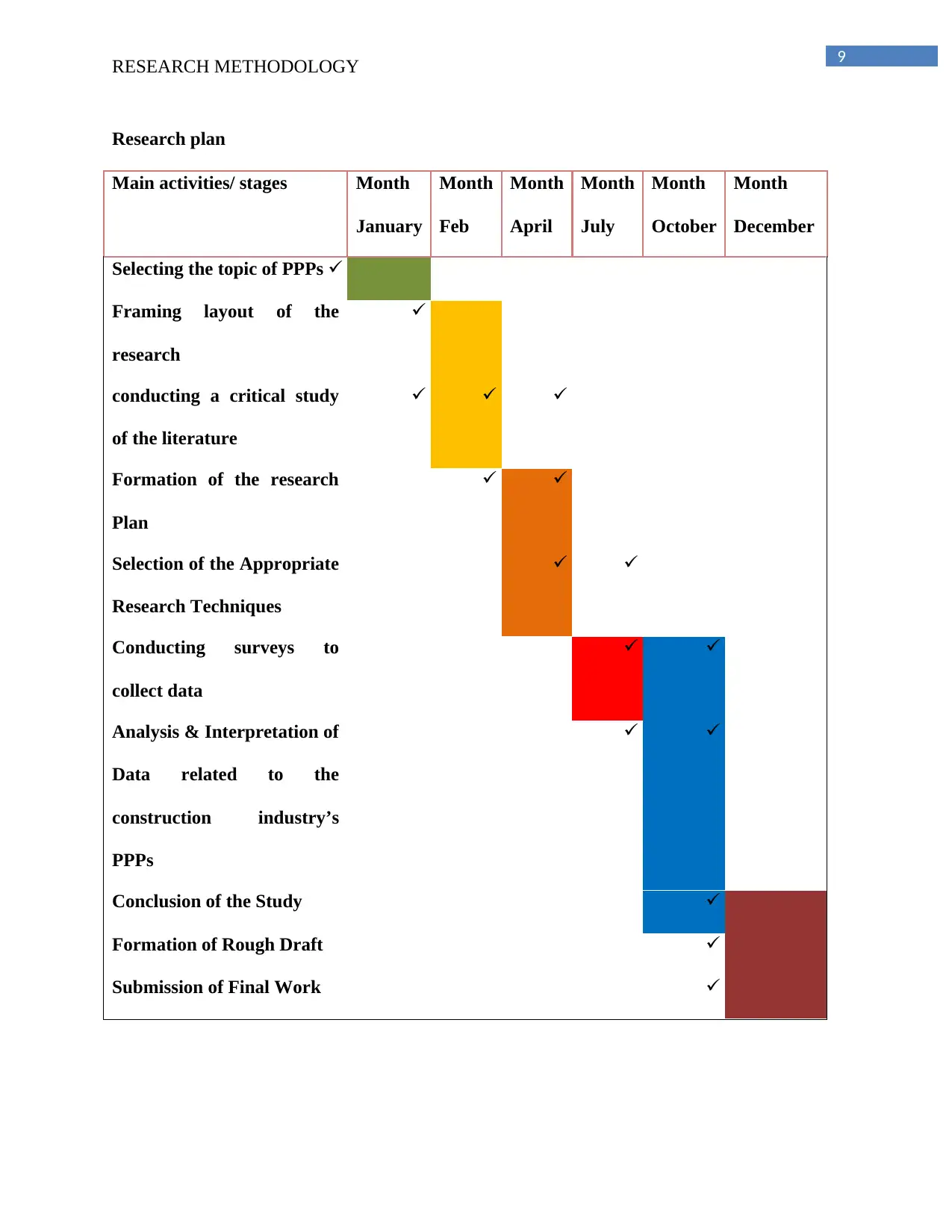
9
RESEARCH METHODOLOGY
Research plan
Main activities/ stages Month
January
Month
Feb
Month
April
Month
July
Month
October
Month
December
Selecting the topic of PPPs
Framing layout of the
research
conducting a critical study
of the literature
Formation of the research
Plan
Selection of the Appropriate
Research Techniques
Conducting surveys to
collect data
Analysis & Interpretation of
Data related to the
construction industry’s
PPPs
Conclusion of the Study
Formation of Rough Draft
Submission of Final Work
RESEARCH METHODOLOGY
Research plan
Main activities/ stages Month
January
Month
Feb
Month
April
Month
July
Month
October
Month
December
Selecting the topic of PPPs
Framing layout of the
research
conducting a critical study
of the literature
Formation of the research
Plan
Selection of the Appropriate
Research Techniques
Conducting surveys to
collect data
Analysis & Interpretation of
Data related to the
construction industry’s
PPPs
Conclusion of the Study
Formation of Rough Draft
Submission of Final Work
Paraphrase This Document
Need a fresh take? Get an instant paraphrase of this document with our AI Paraphraser
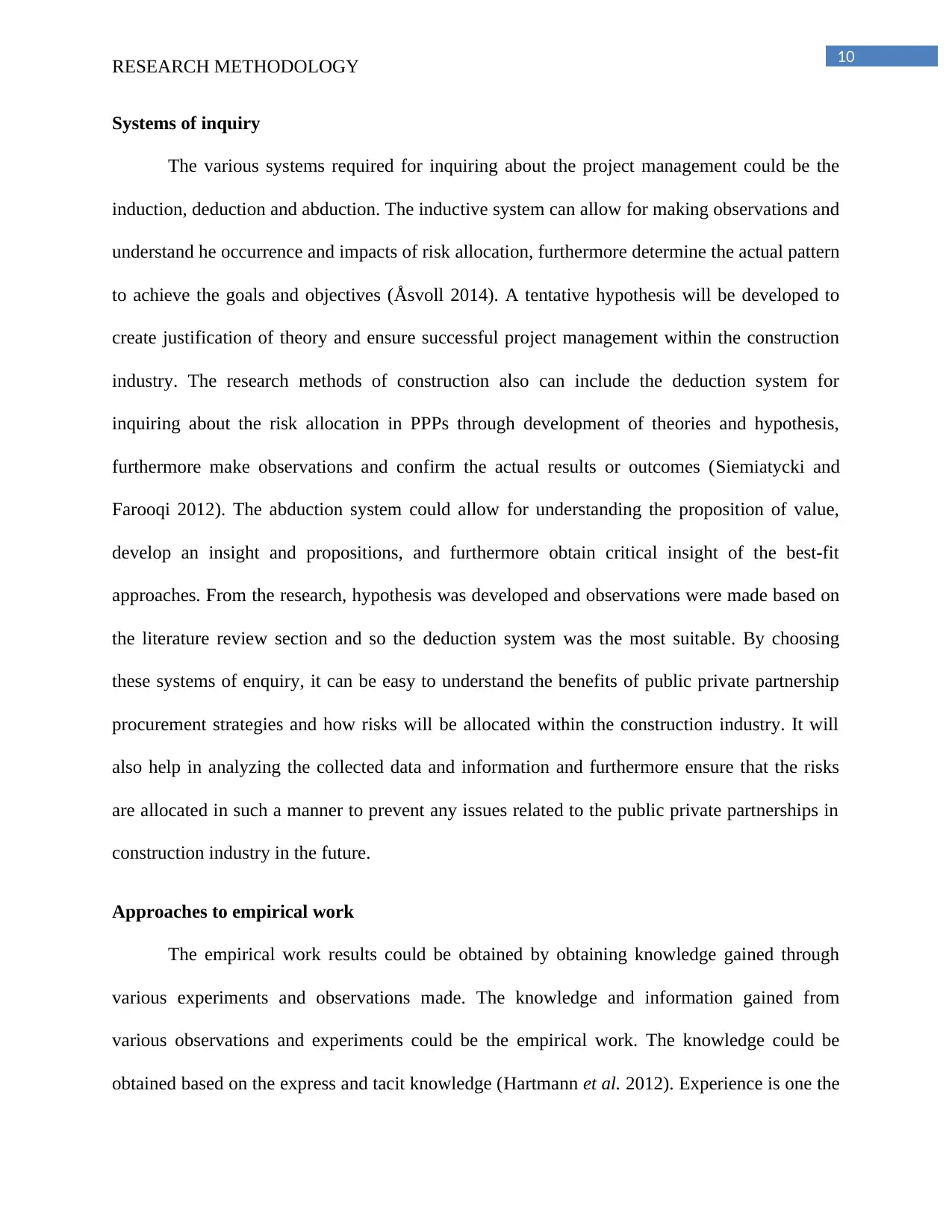
10
RESEARCH METHODOLOGY
Systems of inquiry
The various systems required for inquiring about the project management could be the
induction, deduction and abduction. The inductive system can allow for making observations and
understand he occurrence and impacts of risk allocation, furthermore determine the actual pattern
to achieve the goals and objectives (Åsvoll 2014). A tentative hypothesis will be developed to
create justification of theory and ensure successful project management within the construction
industry. The research methods of construction also can include the deduction system for
inquiring about the risk allocation in PPPs through development of theories and hypothesis,
furthermore make observations and confirm the actual results or outcomes (Siemiatycki and
Farooqi 2012). The abduction system could allow for understanding the proposition of value,
develop an insight and propositions, and furthermore obtain critical insight of the best-fit
approaches. From the research, hypothesis was developed and observations were made based on
the literature review section and so the deduction system was the most suitable. By choosing
these systems of enquiry, it can be easy to understand the benefits of public private partnership
procurement strategies and how risks will be allocated within the construction industry. It will
also help in analyzing the collected data and information and furthermore ensure that the risks
are allocated in such a manner to prevent any issues related to the public private partnerships in
construction industry in the future.
Approaches to empirical work
The empirical work results could be obtained by obtaining knowledge gained through
various experiments and observations made. The knowledge and information gained from
various observations and experiments could be the empirical work. The knowledge could be
obtained based on the express and tacit knowledge (Hartmann et al. 2012). Experience is one the
RESEARCH METHODOLOGY
Systems of inquiry
The various systems required for inquiring about the project management could be the
induction, deduction and abduction. The inductive system can allow for making observations and
understand he occurrence and impacts of risk allocation, furthermore determine the actual pattern
to achieve the goals and objectives (Åsvoll 2014). A tentative hypothesis will be developed to
create justification of theory and ensure successful project management within the construction
industry. The research methods of construction also can include the deduction system for
inquiring about the risk allocation in PPPs through development of theories and hypothesis,
furthermore make observations and confirm the actual results or outcomes (Siemiatycki and
Farooqi 2012). The abduction system could allow for understanding the proposition of value,
develop an insight and propositions, and furthermore obtain critical insight of the best-fit
approaches. From the research, hypothesis was developed and observations were made based on
the literature review section and so the deduction system was the most suitable. By choosing
these systems of enquiry, it can be easy to understand the benefits of public private partnership
procurement strategies and how risks will be allocated within the construction industry. It will
also help in analyzing the collected data and information and furthermore ensure that the risks
are allocated in such a manner to prevent any issues related to the public private partnerships in
construction industry in the future.
Approaches to empirical work
The empirical work results could be obtained by obtaining knowledge gained through
various experiments and observations made. The knowledge and information gained from
various observations and experiments could be the empirical work. The knowledge could be
obtained based on the express and tacit knowledge (Hartmann et al. 2012). Experience is one the
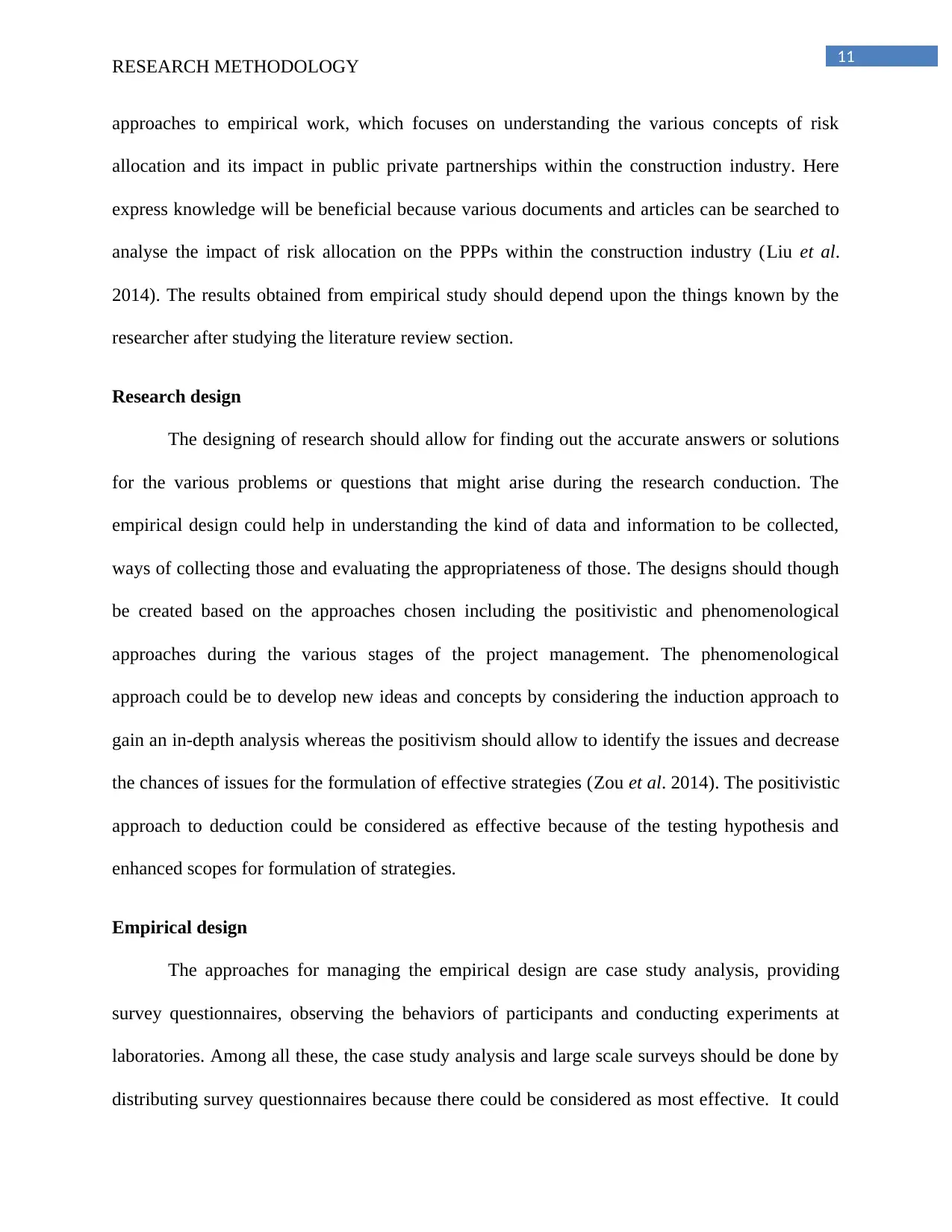
11
RESEARCH METHODOLOGY
approaches to empirical work, which focuses on understanding the various concepts of risk
allocation and its impact in public private partnerships within the construction industry. Here
express knowledge will be beneficial because various documents and articles can be searched to
analyse the impact of risk allocation on the PPPs within the construction industry (Liu et al.
2014). The results obtained from empirical study should depend upon the things known by the
researcher after studying the literature review section.
Research design
The designing of research should allow for finding out the accurate answers or solutions
for the various problems or questions that might arise during the research conduction. The
empirical design could help in understanding the kind of data and information to be collected,
ways of collecting those and evaluating the appropriateness of those. The designs should though
be created based on the approaches chosen including the positivistic and phenomenological
approaches during the various stages of the project management. The phenomenological
approach could be to develop new ideas and concepts by considering the induction approach to
gain an in-depth analysis whereas the positivism should allow to identify the issues and decrease
the chances of issues for the formulation of effective strategies (Zou et al. 2014). The positivistic
approach to deduction could be considered as effective because of the testing hypothesis and
enhanced scopes for formulation of strategies.
Empirical design
The approaches for managing the empirical design are case study analysis, providing
survey questionnaires, observing the behaviors of participants and conducting experiments at
laboratories. Among all these, the case study analysis and large scale surveys should be done by
distributing survey questionnaires because there could be considered as most effective. It could
RESEARCH METHODOLOGY
approaches to empirical work, which focuses on understanding the various concepts of risk
allocation and its impact in public private partnerships within the construction industry. Here
express knowledge will be beneficial because various documents and articles can be searched to
analyse the impact of risk allocation on the PPPs within the construction industry (Liu et al.
2014). The results obtained from empirical study should depend upon the things known by the
researcher after studying the literature review section.
Research design
The designing of research should allow for finding out the accurate answers or solutions
for the various problems or questions that might arise during the research conduction. The
empirical design could help in understanding the kind of data and information to be collected,
ways of collecting those and evaluating the appropriateness of those. The designs should though
be created based on the approaches chosen including the positivistic and phenomenological
approaches during the various stages of the project management. The phenomenological
approach could be to develop new ideas and concepts by considering the induction approach to
gain an in-depth analysis whereas the positivism should allow to identify the issues and decrease
the chances of issues for the formulation of effective strategies (Zou et al. 2014). The positivistic
approach to deduction could be considered as effective because of the testing hypothesis and
enhanced scopes for formulation of strategies.
Empirical design
The approaches for managing the empirical design are case study analysis, providing
survey questionnaires, observing the behaviors of participants and conducting experiments at
laboratories. Among all these, the case study analysis and large scale surveys should be done by
distributing survey questionnaires because there could be considered as most effective. It could
⊘ This is a preview!⊘
Do you want full access?
Subscribe today to unlock all pages.

Trusted by 1+ million students worldwide
1 out of 23
Related Documents
Your All-in-One AI-Powered Toolkit for Academic Success.
+13062052269
info@desklib.com
Available 24*7 on WhatsApp / Email
![[object Object]](/_next/static/media/star-bottom.7253800d.svg)
Unlock your academic potential
Copyright © 2020–2025 A2Z Services. All Rights Reserved. Developed and managed by ZUCOL.




